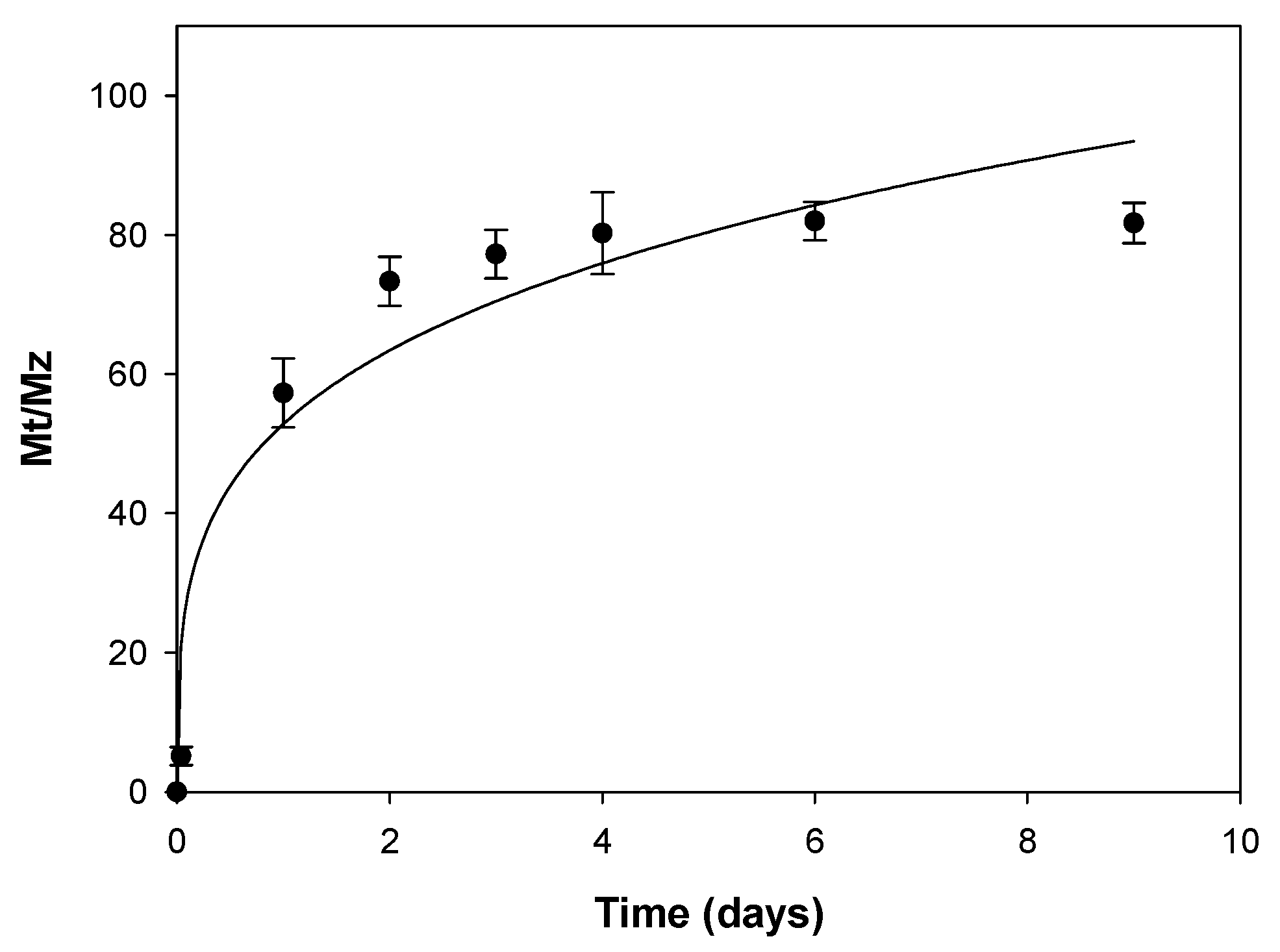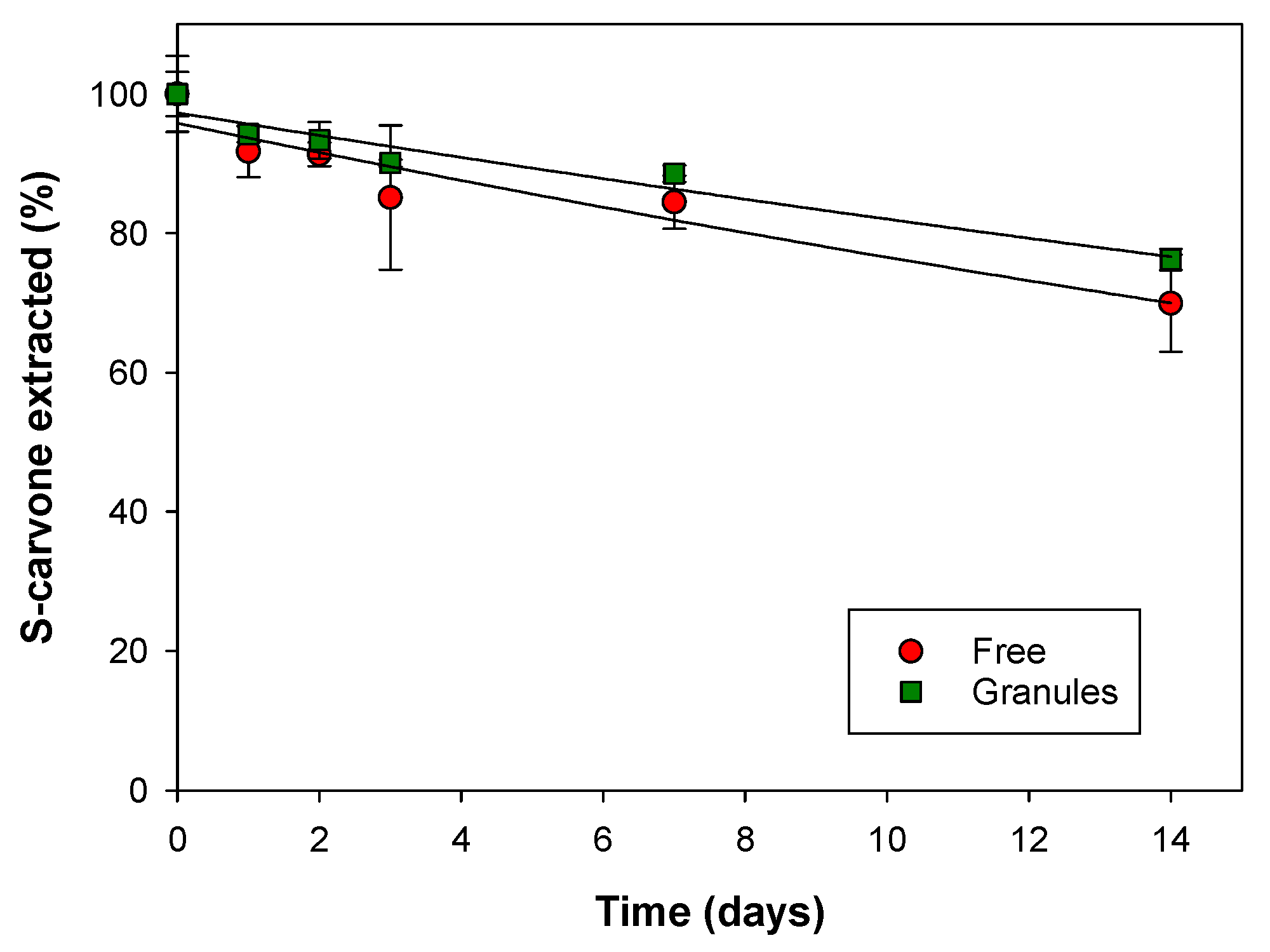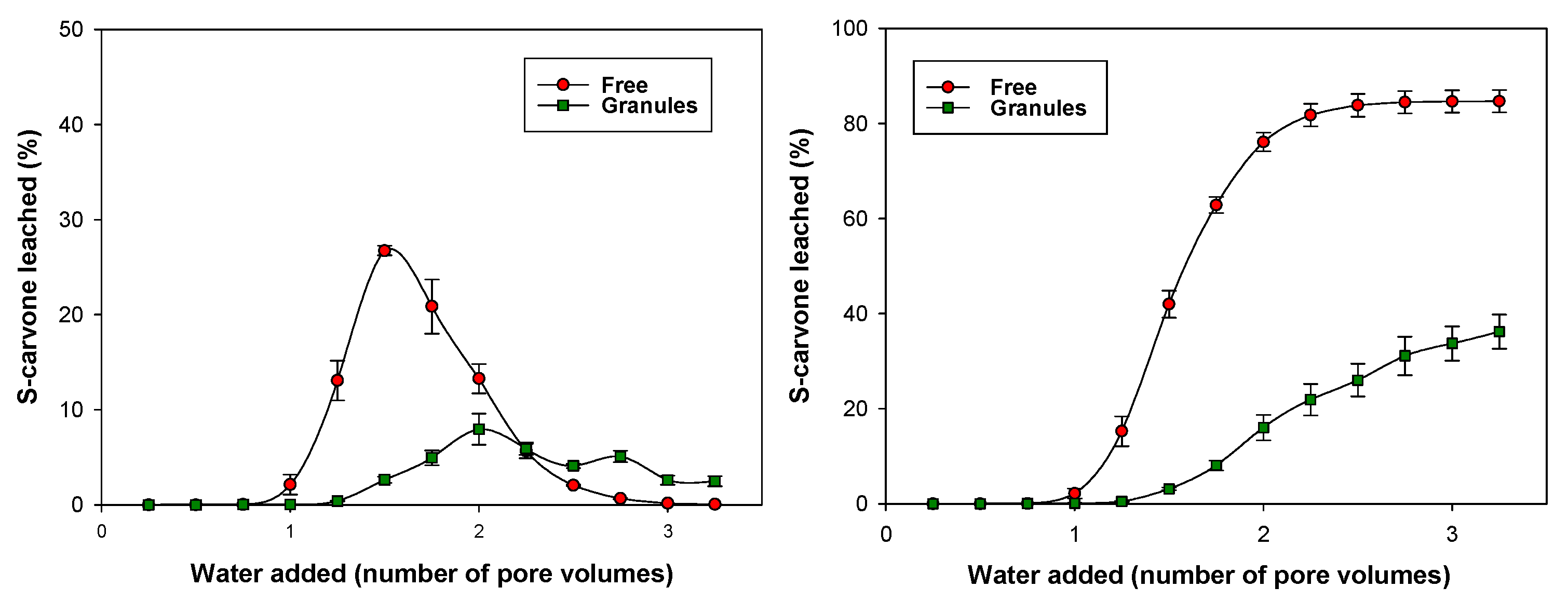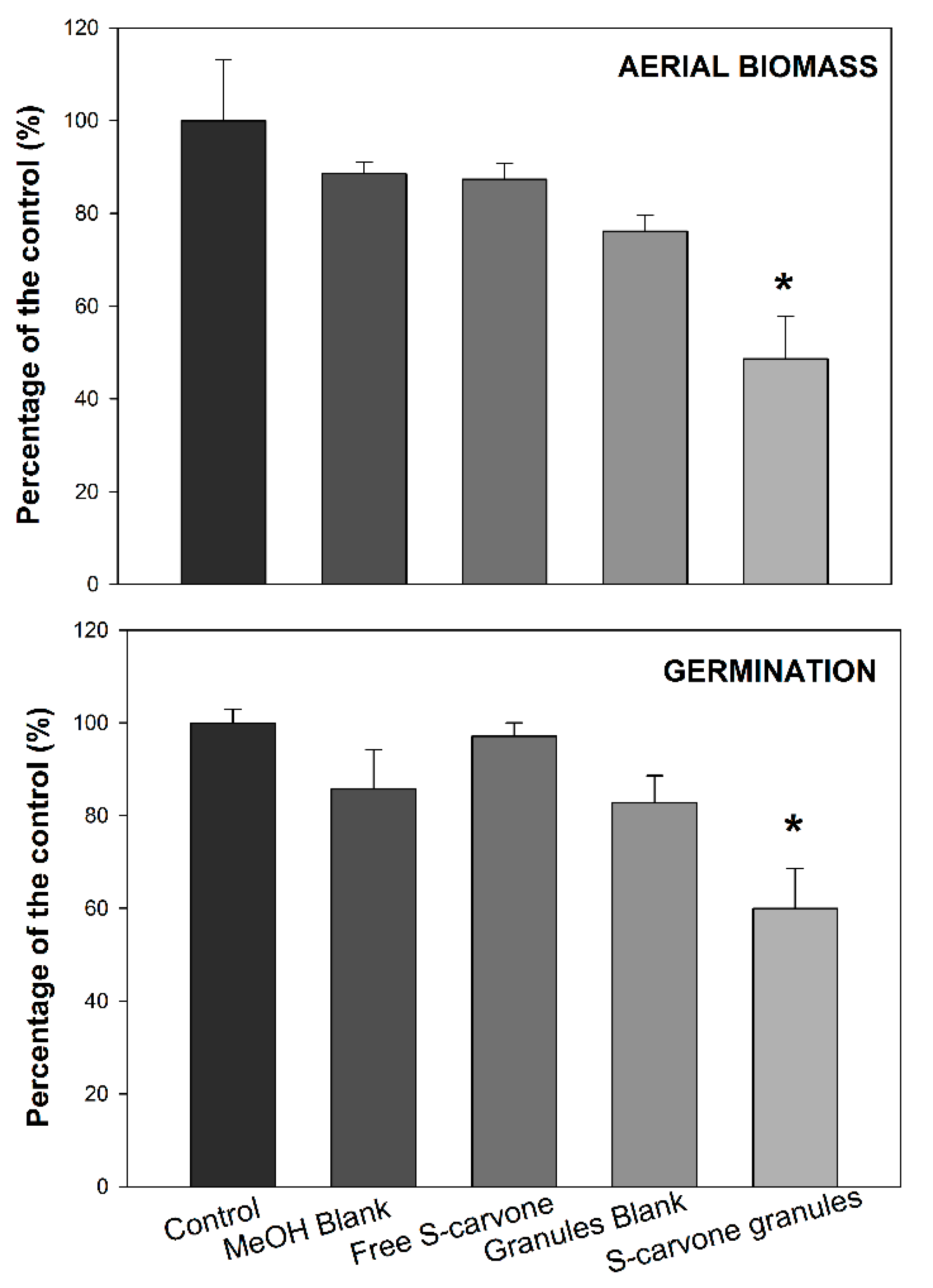S-Carvone Formulation Based on Granules of Organoclay to Modulate Its Losses and Phytotoxicity in Soil
Abstract
:1. Introduction
2. Materials and Methods
2.1. S-Carvone, Organoclay and Soil
2.2. Granulation Procedure
2.3. Preparation of the S-Carvone Formulation
2.4. Batch Release Kinetics
2.5. Dissipation of S-Carvone in Soil
2.6. Leaching of S-Carvone in Soil Columns
2.7. Bioassays
2.8. Analytical Method
2.9. Statistical Analysis
3. Results and Discussion
3.1. S-Carvone Release from Granules
3.2. Dissipation of S-Carvone in Soil
3.3. Leaching of S-Carvone in Soil
3.4. Phytotoxicity of S-Carvone in Soil
4. Conclusions
Supplementary Materials
Author Contributions
Funding
Institutional Review Board Statement
Informed Consent Statement
Conflicts of Interest
References
- Dornelas, A.S.P.; Sarmento, R.A.; Saraiva, A.S.; Barbosa, R.S.; Vieira, M.M.; Gravato, C.; Soares, A.M.V.M. Effects of two biopesticides and salt on behaviour, regeneration and sexual reproduction of the freshwater planarian Girardia Tigrina. J. Hazard. Mater. 2021, 404, 124089. [Google Scholar] [CrossRef]
- Cordeau, S.; Triolet, M.; Wayman, S.; Steinberg, C.; Guillemin, J.-P. Bioherbicides: Dead in the water? A review of the existing products for integrated weed management. Crop Prot. 2016, 87, 44–49. [Google Scholar] [CrossRef]
- Villaverde, J.J.; Sandín-España, P.; Sevilla-Morán, B.; López-Goti, C.; Alonso-Prados, J.L. Biopesticides from natural products: Current development, legislative framework, and future trends. BioResources 2016, 11, 5618–5640. [Google Scholar] [CrossRef] [Green Version]
- Kalra, R.; Conlan, X.A.; Goel, M. Lichen allelopathy: A new hope for limiting chemical herbicide and pesticide use. Biocontrol Sci. Technol. 2021, 1–24. [Google Scholar] [CrossRef]
- Cheng, F.; Cheng, Z. Research progress on the use of plant allelopathy in agriculture and the physiological and ecological mechanisms of allelopathy. Front. Plant Sci. 2015, 6, 1020. [Google Scholar] [CrossRef] [PubMed]
- Gámiz, B.; López-Cabeza, R.; Velarde, P.; Spokas, K.A.; Cox, L. Biochar changes the bioavailability and bioefficacy of the allelochemical coumarin in agricultural soils. Pest Manag. Sci. 2021, 77, 834–843. [Google Scholar] [CrossRef] [PubMed]
- Galán-Pérez, J.A.; Gámiz, B.; Celis, R. Determining the effect of soil properties on the stability of scopoletin and its toxicity to target plants. Biol. Fertil. Soils 2021, 57, 643–655. [Google Scholar] [CrossRef]
- Gámiz, B.; Facenda, G.; Celis, R. Nanoengineered sorbents to increase the persistence of the allelochemical carvone in the rhizosphere. J. Agric. Food Chem. 2019, 67, 589–596. [Google Scholar] [CrossRef] [Green Version]
- Domingues, P.M.; Santos, L. Essential oil of pennyroyal (Mentha pulegium): Composition and applications as alternatives to pesticides—New tendencies. Ind. Crop. Prod. 2019, 139, 111534. [Google Scholar] [CrossRef]
- Gerwick, B.C.; Sparks, T.C. Natural products for pest control: An analysis of their role, value and future. Pest Manag. Sci. 2014, 70, 1169–1185. [Google Scholar] [CrossRef]
- Macías, F.A.; Mejías, F.J.R.; Molinillo, J.M.G. Recent advances in allelopathy for weed control: From knowledge to applications. Pest Manag. Sci. 2019, 75, 2413–2436. [Google Scholar] [CrossRef]
- Laggoune, S.; Öztürk, M.; Erol, E.; Duru, M.E.; Abaza, I.; Kabouche, A.; Kabouche, Z. Chemical composition, antioxidant and antibacterial activities of the essential oil of Mentha spicata L. from Algeria. J. Mater. Environ. Sci. 2016, 7, 4205–4213. [Google Scholar]
- Chaimovitsh, D.; Shachter, A.; Abu-Abied, M.; Rubin, B.; Sadot, E.; Dudai, N. Herbicidal activity of monoterpenes is associated with disruption of microtubule functionality and membrane integrity. Weed Sci. 2017, 65, 19–30. [Google Scholar] [CrossRef] [Green Version]
- Inderjit; Muramatsu, M.; Nishimura, H. On the allelopathic potential of certain terpenoids, phenolics, and their mixtures, and their recovery from soil. Can. J. Bot. Can. Bot. 1997, 75, 888–891. [Google Scholar] [CrossRef]
- Vokou, D.; Douvli, P.; Blionis, G.J.; Halley, J.M. Effects of monoterpenoids, acting alone or in pairs, on seed germination and subsequent seedling growth. J. Chem. Ecol. 2003, 29, 2281–2301. [Google Scholar] [CrossRef]
- Karamanoli, K.; Ainalidou, A.; Bouzoukla, F.; Vokou, D. Decomposition profiles of leaf essential oils in the soil environment. Ind. Crop. Prod. 2018, 124, 397–401. [Google Scholar] [CrossRef]
- Pavela, R.; Benelli, G. Essential oils as ecofriendly biopesticides? Challenges and constraints. Trends Plant. Sci. 2016, 21, 1000–1007. [Google Scholar] [CrossRef] [PubMed]
- He, H.B.; Wang, H.B.; Fang, C.X.; Lin, Y.Y.; Zeng, C.M.; Wu, L.Z.; Guo, W.C.; Lin, W.X. Herbicidal effect of a combination of oxygenic terpenoids on Echinochloa crus-galli. Weed Res. 2009, 49, 183–192. [Google Scholar] [CrossRef]
- Trezzi, M.M.; Vidal, R.A.; Balbinot Junior, A.A.; von Hertwig Bittencourt, H.; da Silva Souza Filho, A.P. Allelopathy: Driving mechanisms governing its activity in agriculture. J. Plant Interact. 2016, 11, 53–60. [Google Scholar] [CrossRef]
- De Albuquerque, M.B.; Dos Santos, R.C.; Lima, L.M.; Melo Filho, P.D.A.; Nogueira, R.J.M.C.; Da Câmara, C.A.G.; Ramos, A.D.R. Allelopathy, an alternative tool to improve cropping systems. A review. Agron. Sustain. Dev. 2011, 31, 379–395. [Google Scholar] [CrossRef] [Green Version]
- Gámiz, B.; Hermosín, M.C.; Celis, R. Appraising factors governing sorption and dissipation of the monoterpene carvone in agricultural soils. Geoderma 2018, 321, 61–68. [Google Scholar] [CrossRef] [Green Version]
- Man, Y.; Wang, B.; Wang, J.; Slaný, M.; Yan, H.; Li, P.; El-Naggar, A.; Shaheen, S.M.; Rinklebe, J.; Feng, X. Use of biochar to reduce mercury accumulation in Oryza sativa L: A trial for sustainable management of historically polluted farmlands. Environ. Int. 2021, 153, 106527. [Google Scholar] [CrossRef] [PubMed]
- Pavela, R.; Benelli, G.; Pavoni, L.; Bonacucina, G.; Cespi, M.; Cianfaglione, K.; Bajalan, I.; Morshedloo, M.R.; Lupidi, G.; Romano, D.; et al. Microemulsions for delivery of Apiaceae essential oils—Towards highly effective and eco-friendly mosquito larvicides? Ind. Crop. Prod. 2019, 129, 631–640. [Google Scholar] [CrossRef]
- Soltys, D.; Krasuska, U.; Bogatek, R.; Gniazdowska, A. Allelochemicals as bioherbicides-present and perspectives. In Herbicides-Current Research and Case Studies in Use; Price, A.J., Kelton, J.A., Eds.; Intech: Houston, TX, USA, 2013; pp. 517–542. [Google Scholar]
- De Mastro, G.; El Mahdi, J.; Ruta, C. Bioherbicidal potential of the essential oils from mediterranean lamiaceae for weed control in organic farming. Plants 2021, 10, 818. [Google Scholar] [CrossRef]
- Damalas, C.A.; Koutroubas, S.D. Current status and recent developments in biopesticide use. Agriculture 2018, 8, 13. [Google Scholar] [CrossRef] [Green Version]
- Ouédraogo, I.W.K.; De Winter, J.; Gerbaux, P.; Bonzi-Coulibaly, Y.L. Volatility profiles of monoterpenes loaded onto cellulosic-based materials. Ind. Crop. Prod. 2013, 51, 100–106. [Google Scholar] [CrossRef]
- Campos, E.V.R.; Proenç, P.L.F.; Oliveira, J.L.; Perei, A.E.S.; Pasquoto-stigliani, T.; Lima, R.; Melville, C.C.; Jaqueline, F. Carvacrol and linalool co-loaded in β-cyclodextrin-grafted chitosan nanoparticles as sustainable biopesticide aiming pest control. Sci. Rep. 2018, 8, 1–14. [Google Scholar] [CrossRef]
- Jain, S.K.; Dutta, A.; Kumar, J.; Shakil, N.A. Preparation and characterization of dicarboxylic acid modified starch-clay composites as carriers for pesticide delivery. Arab. J. Chem. 2020, 13, 7990–8002. [Google Scholar] [CrossRef]
- Gámiz, B.; Hermosín, M.C.; Cornejo, J.; Celis, R. Hexadimethrine-montmorillonite nanocomposite: Characterization and application as a pesticide adsorbent. Appl. Surf. Sci. 2015, 332, 606–613. [Google Scholar] [CrossRef] [Green Version]
- Park, D.H.; Hwang, S.; Oh, J.M.; Yang, J.H.; Choy, J.H. Polymer–inorganic supramolecular nanohybrids for red, white, green, and blue applications. Prog. Polym. Sci. 2013, 38, 1442–1486. [Google Scholar] [CrossRef]
- Guégan, R. Organoclay applications and limits in the environment. Comptes Rendus Chim. 2019, 22, 132–141. [Google Scholar] [CrossRef]
- Sarkar, B.; Xi, Y.; Megharaj, M.; Krishanamurti, G.; Bowman, M.; Rose, H.; Naidu, R. Bioreactive organoclay: A new technology for environmental remediation. Crit. Rev. Environ. Sci. Technol. 2012, 42, 37–41. [Google Scholar] [CrossRef]
- Gámiz, B.; Celis, R.; Hermosín, M.C.; Cornejo, J.; Johnston, C.T. Preparation and characterization of spermine-exchanged montmorillonite and interaction with the herbicide fluometuron. Appl. Clay Sci. 2012, 58, 8–15. [Google Scholar] [CrossRef] [Green Version]
- Phuekphong, A.; Imwiset, K.; Ogawa, M. Designing nanoarchitecture for environmental remediation based on the clay minerals as building block. J. Hazard. Mater. 2020, 399, 122888. [Google Scholar] [CrossRef]
- Slaný, M.; Jankovič, Ľ.; Madejová, J. Structural characterization of organo-montmorillonites prepared from a series of primary alkylamines salts: Mid-IR and near-IR study. Appl. Clay Sci. 2019, 176, 11–20. [Google Scholar] [CrossRef]
- Choy, J.; Choi, S.; Oh, J.; Park, T. Clay minerals and layered double hydroxides for novel biological applications. Appl. Clay Sci. 2007, 36, 122–132. [Google Scholar] [CrossRef]
- Celis, R.; Trigo, C.; Facenda, G.; Hermosín, M.C.; Cornejo, J. Selective modification of clay minerals for the adsorption of herbicides widely used in olive groves. J. Agric. Food Chem. 2007, 55, 6650–6658. [Google Scholar] [CrossRef]
- Cruz-Guzmán, M.; Celis, R.; Hermosín, M.C.; Koskinen, W.C.; Cornejo, J. Adsorption of pesticides from water by functionalized organobentonites. J. Agric. Food Chem. 2005, 53, 7502–7511. [Google Scholar] [CrossRef] [PubMed]
- Bueno, S.; Durán, E.; Gámiz, B.; Hermosín, M.C. Formulating low cost modified bentonite with natural binders to remove pesticides in a pilot water filter system. J. Environ. Chem. Eng. 2021, 9, 104623. [Google Scholar] [CrossRef]
- Gámiz, B.; Celis, R.; Hermosín, M.C.; Cornejo, J. Organoclays as soil amendments to increase the efficacy and reduce the environmental impact of the herbicide fluometuron in agricultural soils. J. Agric. Food Chem. 2010, 58, 7893–7901. [Google Scholar] [CrossRef]
- Trigo, C.; Celis, R.; Hermosín, M.C.; Cornejo, J. Organoclay-based formulations to reduce the environmental impact of the herbicide diuron in olive groves. Soil Sci. Soc. Am. J. 2009, 73, 1652–1657. [Google Scholar] [CrossRef] [Green Version]
- Gámiz, B.; Cox, L.; Hermosín, M.C.; Spokas, K.; Celis, R. Assessing the effect of organoclays and biochar on the fate of abscisic acid in soil. J. Agric. Food Chem. 2017, 65, 29–38. [Google Scholar] [CrossRef] [Green Version]
- Huang, A.; Huang, Z.; Dong, Y.; Chen, L.; Fu, L.; Li, L.; Ma, L. Controlled release of phoxim from organobentonite based formulation. Appl. Clay Sci. 2013, 80–81, 63–68. [Google Scholar] [CrossRef]
- Jiang, L.; Mo, J.; Qin, Y.; Wang, Y.; Dai, L.; Kong, Z.; Ma, L. Effects of organobentonites on imidacloprid release from alginate-based formulation. Appl. Clay Sci. 2015, 105–106, 52–59. [Google Scholar] [CrossRef]
- Du, J.; Chadalavada, S.; Naidu, R. Synthesis of porous bentonite organoclay granule and its adsorption of tributyltin. Appl. Clay Sci. 2017, 148, 131–137. [Google Scholar] [CrossRef]
- Visavale, G.L.; Nair, R.K.; Kamath, S.S.; Sawant, M.R.; Thorat, B.N. Granulation and drying of modified clay incorporated pesticide formulation. Dry. Technol. 2007, 25, 1369–1376. [Google Scholar] [CrossRef]
- Ghrab, S.; Eloussaief, M.; Lambert, S.; Bouaziz, S.; Benzina, M. Adsorption of terpenic compounds onto organo-palygorskite. Environ. Sci. Pollut. Res. 2018, 25, 18251–18262. [Google Scholar] [CrossRef]
- Ghrab, S.; Balme, S.; Cretin, M.; Bouaziz, S.; Benzina, M. Adsorption of terpenes from Eucalyptus globulus onto modified beidellite. Appl. Clay Sci. 2018, 156, 169–177. [Google Scholar] [CrossRef]
- Pesticides Properties Database (PPDB). 2021. Available online: http://sitem.herts.ac.uk/aeru/bpdb/index.htm (accessed on 6 August 2021).
- Pastor, A.; Gámiz, B.; Cruz-Yusta, M.; Sánchez, L.; Pavlovic, I. Carbendazim-clay complexes for its potential use as antimicrobial additives in mortars. Build. Environ. 2020, 183, 107214. [Google Scholar] [CrossRef]
- Cabrera, A.; Celis, R.; Hermosín, M.C. Imazamox-clay complexes with chitosan- and iron(III)-modified smectites and their use in nanoformulations. Pest Manag. Sci. 2016, 72, 1285–1294. [Google Scholar] [CrossRef] [PubMed] [Green Version]
- Celis, R.; Hermosín, M.C.; Carrizosa, M.J.; Cornejo, J. Inorganic and organic clays as carriers for controlled release of the herbicide hexazinone. J. Agric. Food Chem. 2002, 50, 2324–2330. [Google Scholar] [CrossRef] [PubMed]
- Bakkali, F.; Averbeck, S.; Averbeck, D.; Idaomar, M. Biological effects of essential oils—A review. Food Chem. Toxicol. 2008, 46, 446–475. [Google Scholar] [CrossRef]
- Fernández-Pérez, M.; Villafranca-Sánchez, M.; Flores-Céspedes, F.; Pérez-García, S.; Daza-Fernández, I. Prevention of chloridazon and metribuzin pollution using lignin-based formulations. Environ. Pollut. 2010, 158, 1412–1419. [Google Scholar] [CrossRef] [PubMed]
- Vasilakoglou, I.; Dhima, K.; Paschalidis, K.; Ritzoulis, C. Herbicidal potential on Lolium rigidum of nineteen major essential oil components and their synergy. J. Essent. Oil Res. 2013, 25, 1–10. [Google Scholar] [CrossRef]
- Koiou, K.; Vasilakoglou, I.; Dhima, K. Herbicidal potential of lavender (Lavandula angustifolia Mill.) essential oil components on bristly foxtail (Setaria verticillata (L.) P. Beauv.): Comparison with carvacrol, carvone, thymol and eugenol. Arch. Biol. Sci. 2020, 72, 223–231. [Google Scholar] [CrossRef] [Green Version]
- Abrahim, D.; Braguini, W.L.; Kelmer-Bracht, A.M.; Ishii-Iwamoto, E.L. Effects of four monoterpenes on germination, primary root growth, and mitochondrial respiration of maize. J. Chem. Ecol. 2000, 26, 611–624. [Google Scholar] [CrossRef]
- Reynolds, T. Comparative effects of alicyclic compounds and quinones on inhibition of lettuce fruit germination. Ann. Bot. 1987, 60, 215–223. [Google Scholar] [CrossRef]
- Ruiz, M.; Mulas, D.; Prades, J.; Ochoa, J.; Querzola, P.; Edmonds, J. ARAW: Uva sin botritis y sin residuos. Phytoma 2015, 64–68. [Google Scholar]





| Treatment | k (Days−1) | t1/2 (Days) | R2 |
|---|---|---|---|
| S-carvone (Free) | 0.0224 ± 0.0038 | 30 (26–37) | 0.906 |
| S-carvone formulation | 0.0171 ± 0.0023 | 40 (36–47) | 0.936 |
| Treatment | Leached (%) | Extracted (%) | Not Recovered (%) | Position Cmax (Vp) 1 |
|---|---|---|---|---|
| S-carvone (Free) | 85 ± 2 | <1 | 15 | 1.5 |
| S-carvone formulation | 36 ± 4 | 8 ± 3 | 56 | 2.0 |
Publisher’s Note: MDPI stays neutral with regard to jurisdictional claims in published maps and institutional affiliations. |
© 2021 by the authors. Licensee MDPI, Basel, Switzerland. This article is an open access article distributed under the terms and conditions of the Creative Commons Attribution (CC BY) license (https://creativecommons.org/licenses/by/4.0/).
Share and Cite
Gámiz, B.; Celis, R. S-Carvone Formulation Based on Granules of Organoclay to Modulate Its Losses and Phytotoxicity in Soil. Agronomy 2021, 11, 1593. https://doi.org/10.3390/agronomy11081593
Gámiz B, Celis R. S-Carvone Formulation Based on Granules of Organoclay to Modulate Its Losses and Phytotoxicity in Soil. Agronomy. 2021; 11(8):1593. https://doi.org/10.3390/agronomy11081593
Chicago/Turabian StyleGámiz, Beatriz, and Rafael Celis. 2021. "S-Carvone Formulation Based on Granules of Organoclay to Modulate Its Losses and Phytotoxicity in Soil" Agronomy 11, no. 8: 1593. https://doi.org/10.3390/agronomy11081593
APA StyleGámiz, B., & Celis, R. (2021). S-Carvone Formulation Based on Granules of Organoclay to Modulate Its Losses and Phytotoxicity in Soil. Agronomy, 11(8), 1593. https://doi.org/10.3390/agronomy11081593







